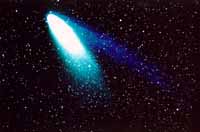Return to Current Site
 |
|
Tailing a Comet
|
TAILING A COMET
Comets--chunks of ice and dust that condensed from the primordial solar nebula--are relics from the earliest times of our solar system. Scientists study them because, like asteroids, they yield important clues about our origins. Comets are nearly invisible except when near the Sun, where they begin to warm up and turn from dark, cold objects into ones so bright that we can see them here on Earth. This transformation occurs when the heat from the Sun vaporizes ice on the comet's surface, causing the resulting gases to glow. The comet's glowing dust and ion tails can extend many millions of kilometers as the comet streaks by in its orbit. Following its primary mission, Deep Space 1 embarked on an ambitious extended mission that culminated in a daring encounter with comet Borrelly on September 22, 2001. Despite being past its intended lifetime and crippled from its long journey, DS1 completed its assignments perfectly, returning the best pictures and other scientific data ever collected at a comet. These data will reveal much to scientists about the nucleus and the coma (the cloud of gas and dust surrounding the nucleus). Subsequent comet missions, including the ones below, will benefit from what DS1 found at comet Borrelly, thus improving the chances these other missions will meet with success by being better prepared. In addition, some of them rely on technologies tested as part of DS1's mission. _____________________________________ Other Missions to Comets: February 1999 (launch)Stardust will arrive within 150 kilometers of the nucleus of Comet Wild 2 (pronounced 'Vilt') in January 2004. It will study the size and shape of the comet's nucleus, the composition of its dust, and will bring back a sample of that dust to Earth using an extraordinary material called aerogel. July 2002 (launch)Contour will encounter Comets Encke (November 2003) and Schwassmann-Wachmann 3 (January 2006), thus improving our knowledge of the characteristics of comet nuclei by assessing their diversity. January 2003 (launch)Rosetta, built by the European Space Agency, will go into a near orbit around Comet Wirtanen in April 2012, and escort it for 17 months as the comet flies in to make its closest approach to the Sun in September 2013. During that time, Rosetta's onboard instruments will map and examine its entire surface and analyse the dust and vapours which will emanate from the comet as the Sun's rays warm it. January 2004 (launch)Deep Impact will reach comet Tempel 1 in July 2005, where it will release a massive daughter spacecraft that will slam into the nucleus, creating a crater that reveals the subsurface material for inspection by the main craft as it flies by. |

